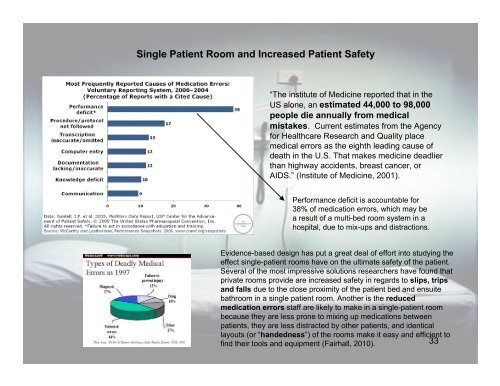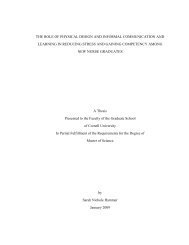The Patient Room: what is the ideal solution? - Cornell University
The Patient Room: what is the ideal solution? - Cornell University
The Patient Room: what is the ideal solution? - Cornell University
You also want an ePaper? Increase the reach of your titles
YUMPU automatically turns print PDFs into web optimized ePapers that Google loves.
Single <strong>Patient</strong> <strong>Room</strong> and Increased <strong>Patient</strong> Safety<br />
“<strong>The</strong> institute of Medicine reported that in <strong>the</strong><br />
US alone, an estimated 44,000 to 98,000<br />
people die annually from medical<br />
m<strong>is</strong>takes. Current estimates from <strong>the</strong> Agency<br />
for Healthcare Research and Quality place<br />
medical errors as <strong>the</strong> eighth leading cause of<br />
death in <strong>the</strong> U.S. That makes medicine deadlier<br />
than highway accidents, breast cancer, or<br />
AIDS.” (Institute of Medicine, 2001).<br />
Performance deficit <strong>is</strong> accountable for<br />
38% of medication errors, which may be<br />
a result of a multi-bed room system in a<br />
hospital, due to mix-ups and d<strong>is</strong>tractions.<br />
Evidence-based design has put a great deal of effort into studying <strong>the</strong><br />
effect single-patient rooms have on <strong>the</strong> ultimate safety of <strong>the</strong> patient.<br />
Several of <strong>the</strong> most impressive <strong>solution</strong>s researchers have found that<br />
private rooms provide are increased safety in regards to slips, trips<br />
and falls due to <strong>the</strong> close proximity of <strong>the</strong> patient bed and ensuite<br />
bathroom in a single patient room. Ano<strong>the</strong>r <strong>is</strong> <strong>the</strong> reduced<br />
medication errors staff are likely to make in a single-patient room<br />
because <strong>the</strong>y are less prone to mixing up medications between<br />
patients, <strong>the</strong>y are less d<strong>is</strong>tracted by o<strong>the</strong>r patients, and identical<br />
layouts (or “handedness”) of <strong>the</strong> rooms make it easy and efficient to<br />
find <strong>the</strong>ir tools and equipment (Fairhall, 2010).<br />
33







